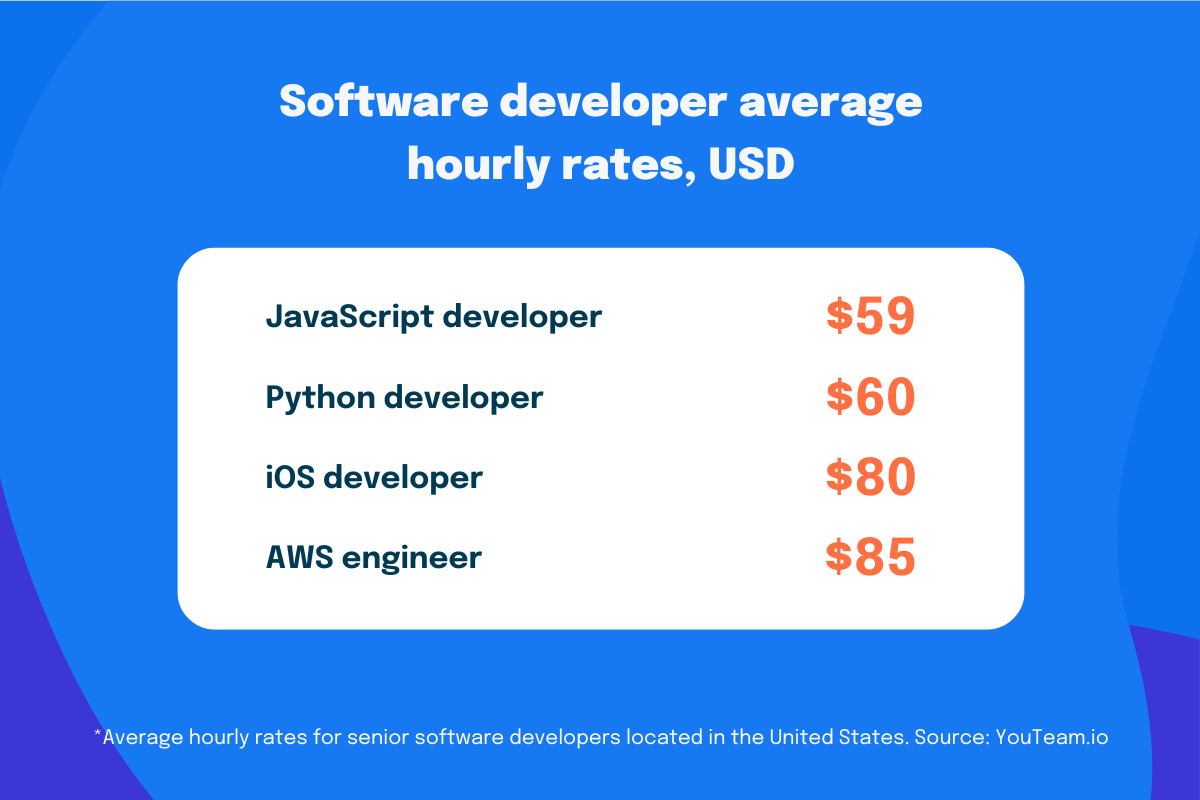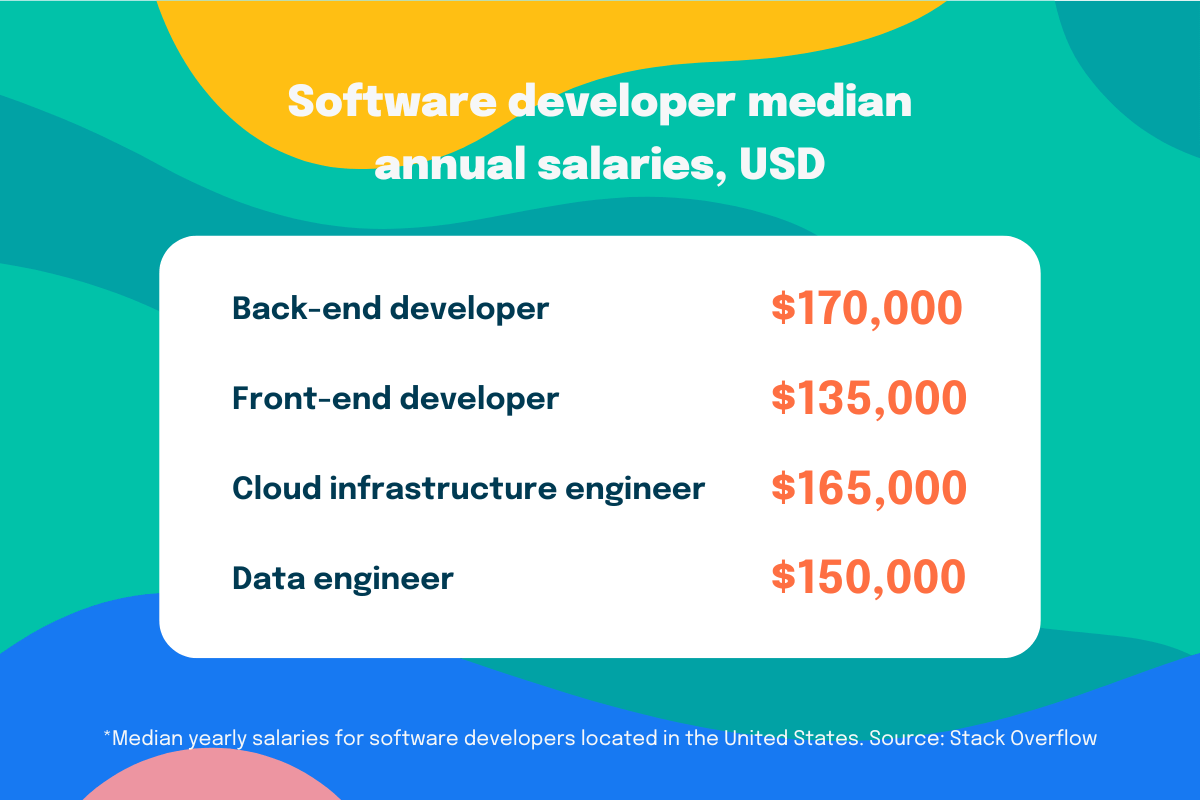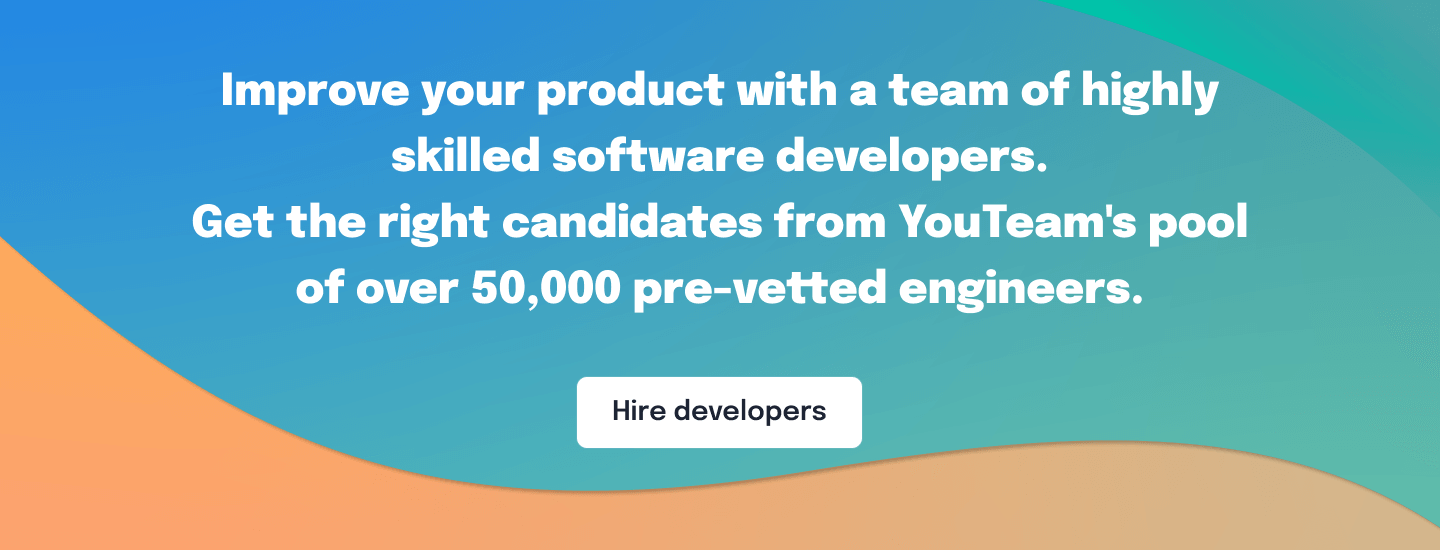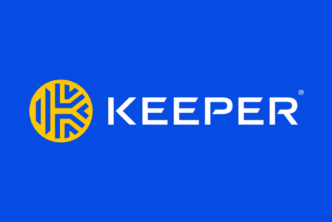In this blog post, we look at the most effective strategies for hiring developers in the United States, exploring their average salaries and hourly rates. We uncover the various levers that companies can use to build successful development teams, from using different hiring channels and creating a structured interview process to developing a strong employer brand. Finally, we highlight the challenges companies face in finding the right talent and discuss how to retain the best software engineers.
Table of Contents
How much does it cost to hire software developers in the U.S.?
We’ve compiled data on the average salaries of senior developers from Glassdoor. This platform considers the earnings of engineers with varying levels of expertise, so actual salaries may differ from case to case.
Salaries in the United States represent the midpoint of the ranges from Glassdoor’s proprietary Total Pay Estimate model and are based on data collected from platform users. These wages consist of a base salary and additional compensation, which may include cash bonuses, commissions, tips, and profit sharing.
| Technology | Median yearly salary, USD | |
| Programming languages | Java | $151,000 |
| JavaScript | $204,000 | |
| PHP | $162,000 | |
| Python | $177,000 | |
| Ruby on Rails | $174,000 | |
| TypeScript | $156,000 | |
| Frameworks / Libraries | Node.js | $195,000 |
| React | $166,000 | |
| React Native | $128,000 | |
| Cloud services | AWS | $137,000 |
| Mobile development | Android | $142,000 |
| iOS | $162,000 |
*Median yearly salaries for software developers located in the United States. Source: Glassdoor
Let’s also consider an alternative source. The 2024 Stack Overflow Developer Survey reveals salaries by developer type. It shows that in the U.S., back-end developers earn a median salary of $170,000, while front-end developers earn $135,000. These figures represent the median total annual compensation, which includes salary, bonuses, and perks, before taxes and deductions, based on data collected from Stack Overflow’s users.
| Developer type | Median yearly salary, USD |
| Mobile developer | $185,000 |
| Back-end developer | $170,000 |
| Cloud infrastructure engineer | $165,000 |
| AI developer | $160,000 |
| Data engineer | $150,000 |
| Front-end developer | $135,000 |
| Full-stack developer | $130,000 |
*Median yearly salaries for software developers located in the United States. Source: Stack Overflow
In addition, we’ve compiled a list of average hourly rates for senior software developers registered on the YouTeam platform. These figures represent the average hourly rates for top-rated software engineers who have experience working remotely and have listed technology as their core expertise.
| Technology | Average hourly rate, USD | |
| Programming languages | Java | $67 |
| JavaScript | $59 | |
| PHP | $68 | |
| Python | $60 | |
| Ruby on Rails | $46 | |
| TypeScript | $77 | |
| Frameworks / Libraries | Node.js | $67 |
| React | $62 | |
| React Native | $60 | |
| Vue.js | $62 | |
| Cloud services | AWS | $85 |
| Mobile development | Android | $50 |
| iOS | $80 |
*Average hourly rates for senior software developers located in the United States. Source: YouTeam.io
Which is the best way to hire software developers in the U.S.?
To stay ahead of the competition in finding the best talent, recruiting must be a continuous process. You need to consistently look for new candidates, refine the interview process, and strengthen your company’s brand – not just when the demand for staff is high. In addition, companies should use various channels to identify the best engineers, which we’ll discuss.
Use job boards and social media
Promote your open position on LinkedIn, Indeed, and Wellfound (formerly AngelList Talent) and share it on the company’s social media accounts. Make sure your job description is clear, includes both the required skills and experience, and highlights the benefits of working for your company.
In addition, create a dedicated careers page on your company’s website featuring current job openings.
Encourage employee referrals
Hiring managers and tech leaders can share a list of current openings with employees, encouraging them to reach out to software engineers in their network. Some companies also offer employee referral programs, rewarding staff with incentives like bonuses or extra paid time off if their recommendation leads to a successful hire.
Consider hiring remote developers
For in-house talent, use platforms like Indeed and Wellfound, where you can specify if your job opening offers remote or hybrid options. For engineering contractors, consider platforms like YouTeam, Arc, and Toptal, which provide flexible arrangements for both short-term commitments and permanent hires, along with risk-free trials and ongoing support. You can also turn to Upwork freelancers for short-term projects or smaller tasks.
Join tech communities
Participate in tech meetups and conferences to connect with potential hires and other industry leaders. These events not only increase your company’s visibility but also provide opportunities to gain valuable advice and explore different approaches to the hiring process from fellow tech executives.
Build a structured hiring process
The hiring process should include candidate sourcing, personal interviews, technical tests, and cultural fit evaluations. Ensure the process flows seamlessly and clearly explain each step to the candidate, providing feedback along the way. While delays in management approvals can happen, be transparent about how long candidates should expect to wait. However, the longer you weigh your options, the more likely it is that a developer will accept another offer.
Focus on your employer brand
Define your company’s mission, values, vision, and culture. By having open conversations with your employees, you’ll gain a better understanding of what your business needs and their aspirations have in common, helping you identify the type of talent needed to achieve your goals. Create a list of unique business values and incorporate these into your website, recruitment materials, and LinkedIn page.
In addition, use your website or social media to showcase your work environment, team, and employee testimonials.
Browse 500+ Dev Teams Available for Hire
How to assess a software developer’s technical skills?
Make sure to have a standardized interviewing process to make it easier to compare candidates fairly and identify the right fit. Prepare a list of the most important questions and draft possible answers. Start by asking about candidates’ ambitions and priorities to determine if their career path aligns with the company’s goals. Then, move on to assess their technical prowess. Based on our experience interviewing remote software developers, here are some questions we usually recommend to our clients:
- What are you looking for in your next position?
- What has been your most recent professional achievement? Are there any projects that you executed exceptionally well?
- How long would it take you to learn a new technology or build a specific skill set?
- What are development tools that you’re just not interested in or struggle to use?
- Give an example where you faced poor software architecture. How did you approach that problem?
- How do you manage the expectations of non-technical team members and clients on a project? Can you provide examples of situations where you had to explain complex concepts or negotiate realistic deadlines in light of an ambitious project scope?
Companies can also use virtual skill assessments or provide software developers with paid trial projects that simulate the real tasks they will encounter on the job.
Finally, it’s crucial to assess how a candidate’s values and behaviors align with your company’s culture. Since engineers interact with different departments, they need strong interpersonal skills, such as active listening, emotional intelligence, and clear communication.
How to write a software developer job description for your project
The main purpose of a job description is to attract the right candidates – and avoid those who are not suited for the role. It should find a masterful blend of clarity and enthusiasm, outlining the desired skill set, key responsibilities, and details about your company and its culture. If your core values include teamwork and open communication, or if your company promotes creativity and fresh thinking, be sure to highlight these in the job posting.
Keep the text concise – aim for no more than one page. Just as recruiters prefer brief resumes, developers appreciate job descriptions that are easy to scan for details.
Here is a template you can follow:
- Job title
- Location
- Brief introduction to your company and its mission
- Key tasks and responsibilities
- Required skills and “nice-to-have” qualifications
- Education and experience
- Salary and benefits (e.g., health insurance, remote work options, professional development)
- Application process
Challenges U.S. companies face in hiring and retaining software development teams
1. Facing salary expectations
Small and midsize enterprises may struggle to match the salaries and benefits offered by tech heavyweights like Amazon and Apple. Software developers with a unique skill set or an impressive portfolio under their belt regularly receive messages from recruiters, and are often tempted by more substantial income and ambitious projects.
As an alternative to a competitive fixed salary, a company can offer equity compensation, which may motivate employees to work more diligently and creatively. In addition, developers consider more than just salary when evaluating a job; they look at the full package. Offering flexible work arrangements, additional paid time off, access to coding workshops, childcare subsidies, and gym memberships are proven ways to demonstrate that a company values its people.
But let’s imagine we have a highly skilled candidate whose primary concern is securing a competitive salary. If they hint at a salary revision early on, and the company is unsure whether it can meet these expectations in the long run, there is a risk of losing the employee if their financial reward is not adjusted after a certain period. In such a case, the company must also consider the time and effort required to onboard and integrate a replacement into the team.
2. Competition for specialized skills
Startups and small companies often require versatile developers, making it challenging to find candidates who are proficient in multiple fields. Furthermore, skills such as blockchain development, machine learning, cloud computing, and DevOps have a higher entry threshold, as they demand extensive knowledge and perseverance. Consequently, these specialists are also difficult to attract.
The competition for specialized skills is closely tied to companies striving to offer better salaries, and competitive salaries are actually a key strategy for attracting top-tier talent.
Alternatively, companies can look for highly promising candidates and provide them with on-the-job training and mentoring. However, such initiatives imply that you already have some specialists with these niche skills within your organization.
Finally, consider expanding your search beyond traditional hiring hotspots to find remote talent. Remote workers in smaller cities or rural areas may have lower salary expectations. You can even tap into a global talent pool to find the right skills and save costs; however, this option requires managing developers across different time zones.
3. Meeting the demand for remote work and flexibility
While Spotify continues to offer flexible work-from-home arrangements, emphasizing that their employees are “not children,” Amazon takes a different stance, telling employees they can quit if they don’t want to return to the office. Although studies on remote worker productivity yield mixed results, the growing demand from technical talent to work where it’s most convenient is something companies can no longer ignore. People value flexibility and hate spending 30 hours a month commuting. A mandatory requirement to work at the office could push candidates and existing staff away, particularly top engineers who can easily find new jobs elsewhere.
Moreover, companies that limit hiring to local employees face a much smaller talent pool and intense competition.
4. Keeping up with the latest technology
The adoption of new technologies can take many forms, such as creating entirely new components or products in line with emerging trends like virtual assistants or augmented and virtual reality (AR/VR) applications. It might also involve transitioning to a microservices infrastructure, implementing modern DevOps practices, or building cross-functional teams.
The sooner you decide to modernize your systems, the better, particularly if a significant portion of your codebase consists of legacy code. Software engineers with experience in both older systems and the latest technologies are becoming increasingly rare.
Another challenge is that existing employees may resist changes in technology and tools, perceiving them as radical or disruptive. To overcome this, companies should clearly communicate their goals, explain the long-term benefits, and implement changes gradually – first testing a pilot project and then expanding based on the feedback received.
5. Preventing employee burnout
Struggling to find energy for projects and tasks is a common issue in the fast-paced, demanding field of software development. This is frequently reflected in a decline in performance, such as an increase in errors, missed deadlines, and a general lack of initiative.
Although it varies for everyone, developers can experience burnout as early as two months into their new position, shortly after onboarding. One of the quickest paths to burnout is multitasking, which leads to physical and mental exhaustion, as well as memory problems. Multitasking is a myth – developers simply switch between tasks, often doing each one less efficiently. Shifting a developer’s focus to one task at a time and eliminating unnecessary meetings that disrupt workflow is an effective way to promote a healthy work routine.
Another cause of burnout is assigning developers repetitive tasks that lack complexity. Engineering talent thrives on growth. With new technologies constantly emerging and older ones updating, companies should encourage developers to learn and apply more complex tasks to practical experience.
Finally, promoting fair compensation may seem like a cure-all, as we’ve repeatedly mentioned this approach for attracting and retaining top talent in previous sections. However, it’s crucial to ensure that salaries and benefits are aligned with current industry standards and reflect the developer’s level of experience.
6. Employee disengagement
Employees can sometimes feel like insignificant gears in a massive engine, especially those working for large companies. The feeling of being mentally distant can be subtle and often goes unspoken, but many engineers take time off for mental health reasons. Unclear role expectations, lack of autonomy, and limited opportunities to collaborate with other departments on projects or experiments are just a few reasons developers may feel disconnected from the company’s mission.
If you sense that your developers are struggling to take initiative, it’s time to act. Create a psychologically safe environment where you can express your concern and discuss the changes you’ve noticed in their behavior. Some developers may be dissatisfied with the monotony of their tasks or the lack of challenges that would allow them to grow their skills. Others may naturally be more critical and lack enthusiasm. It’s also possible that the issue isn’t with the developer but with the company, which may be expecting an unrealistic, almost cult-like level of engagement from its employees.
Offer developers clear, achievable goals, and give them the freedom to pursue them in their own way. Let them know that hitting those goals could open up more chances for growth and new responsibilities.
Final thoughts
We’ve covered the key aspects of finding top talent in this paper, but there’s one more crucial point: in order to attract top talent, you should have a team consisting of top talent itself. Founders should demonstrate their competence and commitment to the project. Not only does this set an example and inspire others to strive for excellence, but it also helps developers feel more confident and tackle challenges more effectively when they see their leaders fully invested.
Why choose YouTeam to hire remote developers?
Since its founding in 2014 as a marketplace for hiring tech talent, YouTeam has been helping Fortune 500 companies, midsize enterprises, and YC startups expand their development teams with diverse and skilled professionals. The process of hiring software engineers through YouTeam is as follows:
- Book a call: You describe your project goals and the vision of your ideal candidate.
- Create an ideal candidate profile: Your Matching Expert creates a profile that meets your criteria, including the relevant tech stack, industry experience, desired portfolio of projects, and type of cooperation.
- Get a shortlist of the matching developers: YouTeam finds suitable engineers and pre-screens talent to create a shortlist of candidates who most closely match your ideal candidate profile. The first batch of profiles will be ready in 48 hours.
- Review candidates: You receive and review your candidate shortlist, selecting which software engineers you want to interview.
YouTeam advocates for confident hiring and collaboration. The company provides locally compliant contracts, a 1-month risk-free trial period, and dispute resolution procedures.
The platform also ensures secure intellectual property (IP) transfer and implements security measures to prevent the unauthorized processing of personal data.










